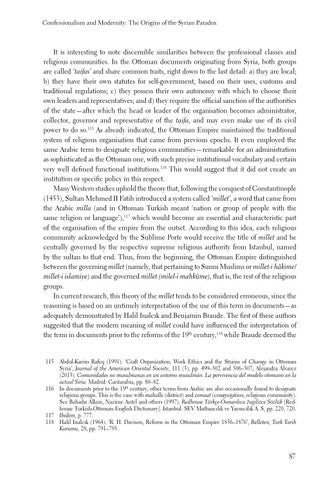Confessionalism and Modernity: The Origins of the Syrian Paradox
It is interesting to note discernible similarities between the professional classes and religious communities. In the Ottoman documents originating from Syria, both groups are called ‘taifas’ and share common traits, right down to the last detail: a) they are local; b) they have their own statutes for self-government, based on their uses, customs and traditional regulations; c) they possess their own autonomy with which to choose their own leaders and representatives; and d) they require the official sanction of the authorities of the state—after which the head or leader of the organisation becomes administrator, collector, governor and representative of the taifa, and may even make use of its civil power to do so.115 As already indicated, the Ottoman Empire maintained the traditional system of religious organisation that came from previous epochs. It even employed the same Arabic term to designate religious communities—remarkable for an administration as sophisticated as the Ottoman one, with such precise institutional vocabulary and certain very well defined functional institutions.116 This would suggest that it did not create an institution or specific policy in this respect. Many Western studies uphold the theory that, following the conquest of Constantinople (1453), Sultan Mehmed II Fatih introduced a system called ‘millet’, a word that came from the Arabic milla (and in Ottoman Turkish meant ‘nation or group of people with the same religion or language’),117 which would become an essential and characteristic part of the organisation of the empire from the outset. According to this idea, each religious community acknowledged by the Sublime Porte would receive the title of millet and be centrally governed by the respective supreme religious authority from Istanbul, named by the sultan to that end. Thus, from the beginning, the Ottoman Empire distinguished between the governing millet (namely, that pertaining to Sunni Muslims or millet-i hâkime/ millet-i islamiye) and the governed millet (milel-i mahkûme), that is, the rest of the religious groups. In current research, this theory of the millet tends to be considered erroneous, since the reasoning is based on an untimely interpretation of the use of this term in documents—as adequately demonstrated by Halil Inalcık and Benjamin Braude. The first of these authors suggested that the modern meaning of millet could have influenced the interpretation of the term in documents prior to the reforms of the 19th century,118 while Braude deemed the
115 Abdul-Karim Rafeq (1991). ‘Craft Organization, Work Ethics and the Strains of Change in Ottoman Syria’, Journal of the American Oriental Society, 111 (3), pp. 499–502 and 506–507; Alejandra Álvarez (2013). Comunidades no musulmanas en un entorno musulmán. La pervivencia del modelo otomano en la actual Siria. Madrid: Cantarabia, pp. 80–82. 116 In documents prior to the 19th century, other terms from Arabic are also occasionally found to designate religious groups. This is the case with mahalle (district) and cemaat (congregation, religious community). See Bahadır Alkım, Nazime Antel and others (1997). Redhouse Türkçe-Osmanlıca İngilizce Sözlük [Redhouse Turkish-Ottoman English Dictionary]. Istanbul: SEV Matbaacılık ve Yayıncılık A. S, pp. 220, 720. 117 Ibidem, p. 777. 118 Halil Inalcık (1964). ‘R. H. Davison, Reform in the Ottoman Empire 1856–1876’, Belleten, Turk Tarih Kurumu, 28, pp. 791–793.
87
